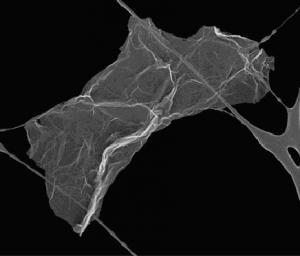The following article was sent to us by Corey McCarren and Dr. Elena Polyakova from Graphene Laboratories (a Graphene-Info sponsor), discussing Graphene Oxide and its applications:
Graphene, a multi or single layer sheet of graphite, is considered a key material in producing the next generation of low-cost carbon-based transparent and flexible electronics. Graphene is the strongest material available, as well as being highly transparent, flexible, and the best conductor of heat and electricity. Great effort is devoted to developing an effective yet inexpensive way to produce graphene materials in industrial quantities.

Graphene Oxide is a single-atomic-layered material made by the oxidation of graphite crystals, which are inexpensive and abundant. It is dispersible in water, and as a result is easy to process. Most importantly, it can be converted into graphene. Graphene Oxide is one of the first commercial graphene materials and one of the most popular products in the Graphene Supermarket. Below, we provide a brief but comprehensive review of the major application areas of Graphene Oxide.
Production of Graphene Oxide
Graphene Oxide is the oxidized form of graphene produced by oxidizing crystal graphite with a mixture of sulfuric acid, sodium nitrate, and potassium permanganate (the Hummers method). Structurally, Graphene Oxide can be visualized as a graphene sheet with its basal plane decorated by oxygen-containing groups. Due to high affinity to water molecules by these groups, Graphene Oxide is hydrophilic and can be dissolved in water. The solubility in water makes the deposition of the thin films of the Graphene Oxide straightforward. Graphene Oxide is a poor conductor but its treatment by light, heat, or chemical reduction can restore most properties of the famed pristine graphene. Conventionally, the reduction is done by hydrazine. The are other "green" methods available, such as introduction of bacteria containing cytochromes.
Transparent Conductive Films
One of the major areas where graphene oxide can be expected to be used is in the production of transparent conductive films. Graphene Oxide films can be deposited on essentially any substrate, and later converted into a conductor. Such coatings can be used in flexible electronics, solar cells, liquid crystal devices (editor: also OLED devices), chemical sensors, and as an indium tin-oxide (ITO) replacement. ITO is the current material of choice for touch screen devices.
Composites and Paper-like Materials
Graphene Oxide mixes readily with many polymers, forming nanocomposites, and greatly enhances the properties of original polymer; this includes elastic modulus, tensile strength, electrical conductivity, and thermal stability. In its solid form, Graphene Oxide flakes tend to attach one to another, forming thin and extremely stable paper-like structures that can be folded, wrinkled, and stretched. Such free-standing Graphene Oxide films are considered for applications including hydrogen storage applications, ion conductors, and nanofiltration membranes.
Energy-Related Materials
Graphene Oxide and its reduced forms have an extremely high surface area; because of this, these materials are considered are for usage as electrode material in batteries and double-layered capacitors, as well as fuel cells and solar cells[3]. Production of Graphene Oxide can be easily scaled up compared to other graphene materials, and therefore may soon be used for energy-related purposes. Its ability to store hydrogen may, in the future, prove very useful for the storage of hydrogen fuel in hybrid cars. Graphene Supermarket offers Reduced Graphene Oxide with Brunauer-Emmett-Teller (BET) Specific Surface Area as high as 833 m2/g.
Applications in Biology and Medicine
Graphene Oxide was found to be fluorescent, which opened a route for applications in bio-sensing, early disease detection, and even assisting in carrying cures for cancer. Graphene Oxide has been successfully used in fluorescent-based biosensors for the detection of DNA and proteins, with a promise of better diagnostics of HIV. Furthermore, Graphene Oxide is tested as a drug carrier. It is likely superior to many other anticancer drugs because it does not target healthy cells, only tumors, and has a low toxicity[4].
Antibacterial Materials
The growth of E. Coli bacteria may be suppressed when disrupted by Graphene Oxide. Because production of Graphene Oxide is inexpensive, it may be mass produced when its applications come to market. When this happens, it will open many doors for developing antibacterial materials, and may assist in healing wounds by killing bacteria. These materials can be made into a thin paper used for packaging meats, which will prove more sanitary than current packaging methods[5].
Graphene Oxide Sheets at Interfaces
Graphene Oxide’s properties include the ability to act as a surfactant, similar to how soap or shampoo would make a stain disperse in water. This ability can be used as an agent for dispersion of insoluble materials such as carbon nanotubes[6].
Graphene Oxide is a material with almost unlimited potential, and is commercially available at reasonable prices due to the inexpensive methods of production. Will you be the one to make the next great breakthrough?
Authored by Corey McCarren and Dr. Elena Polyakova of Graphene Laboratories, Inc., Operator of Graphene Supermarket, a leading supplier of graphene products. To order Graphene Oxide from Graphene Supermarket, visit www.graphene-supermarket.com. Graphene Supermarket offers Graphene Oxide both in its liquid and solid forms.
Want to know more? Here is recommended reading.
1. The Chemistry of Graphene Oxide. Daniel R. Dreyer, Sungjin Park, Christopher W. Bielawski and Rodney S. Ruoff. Chem. Soc. Rev. 2010, 39, 228-240
2. Reduction of Graphene Oxide via Bacterial Respiration.
3. Graphene and Graphene Oxide: Synthesis, Properties, and Applications. Yanwu Zhu, Shanthi Murali, Weiwei Cai, Xuesong Li, Ji Won Suk, Jeffrey R. Potts, Rodney S. Ruoff. Advanced Materials, Volume 22, Issue 35, pages 39063924
4. Multi-functionalized graphene oxide based anticancer drug-carrier with dual-targeting function and pH-sensitivity. Xiaoying Yang, et.al J. Mater. Chem., 2011, 21, 3448-3454
5. Graphene-Based Antibacterial Paper. Wenbing Hu, Cheng Peng, Weijie Luo, Min Lv, Xiaoming Li, Di Li, Qing Huang and Chunhai Fan ACS Nano, 2010, 4 (7), pp 43174323
6. Graphene Oxide Sheets at Interfaces. Jaemyung Kim, Laura J. Cote, Franklin Kim, Wa Yuan, Kenneth R. Shull and Jiaxing Huan, Journal of the American Chemical Society 2010 132 (23), 8180-8186

